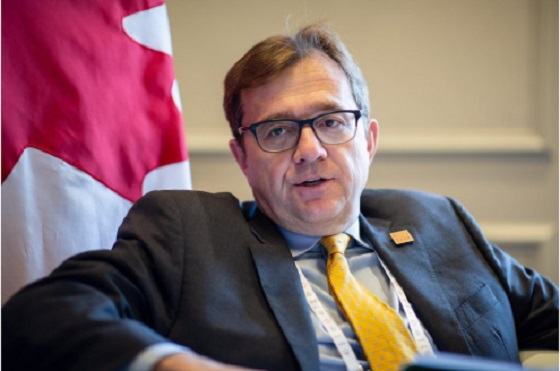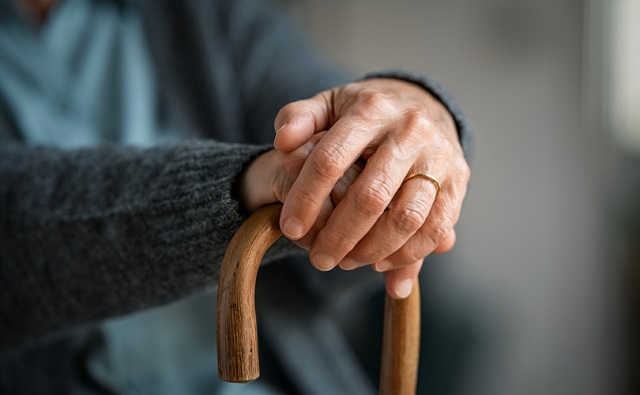Energy
LATE TO THE PARTY: Liberal Resource Minister Minister Suddenly Discovers Canada Needs East-West Pipeline

From Energy Now
By Jim Warren
On Thursday, February 6 federal energy and natural resources Minister Jonathan Wilkinson told reporters about a brilliant idea he’d come up with. He said Canada should think about building an east-west oil pipeline. He claimed doing so could provide Ontario, Quebec and parts further east greater security of supply.
Furthermore, such a pipeline would eliminate the need to buy tanker loads of oil from places like Saudi Arabia and Nigeria. And what’s more it could provide us with the opportunity to export Canadian oil to countries other than the US.
Talk about being late to the party. It’s as though the Energy East project never made it onto the national agenda.
Wilkinson told reporters how a pipeline like Enbridge’s Line 5 is vulnerable to shut down by US authorities. Line 5 carries oil from the prairies through the northern US Midwest before delivering it to the refinery and petrochemicals facilities at Sarnia, Ontario.
This is not breaking news. The Liberals have been well aware of the threat for years. Michigan governor, Gretchen Whitmer waged a well-publicized multi-year campaign to have Line 5 shut down.
According to a CBC report, Wilkinson said, “successive Canadian governments never really gave it much thought that a lot of the energy the country needs to power its economy flows through the U.S.”
That’s a stretch. He apparently doesn’t consider the governments of Alberta and Saskatchewan to be Canadian governments. The real problem is Ottawa wasn’t listening when premiers Notley, Kenney, Smith, Wall and Moe explained the value of an all-Canadian Energy East pipeline. They also had plenty to say about the cancellation of Energy East in 2017 and the role Ottawa played by creating the regulatory approval quagmire that helped kill it.
No less puzzling is that Wilkinson imagines such a pipeline could ever be built under the BANANAs (build absolutely nothing, anywhere, near anything) regulatory barriers implemented by the Liberals which make it next to impossible for anyone to build a new pipeline. When Jason Kenney referred to Bill C-69 as The No More Pipelines Bill he wasn’t just whistling Dixie.
The only major export pipeline to be built in the wake of C-69, was the Trans Mountain expansion (TMX). And it was only completed because the owner, the Government of Canada, was prepared to incur the staggering costs of navigating its own pipeline approval regulations. A pipeline originally budgeted to cost $6.8 billion wound up costing an additional $54 billion. Sane investors simply aren’t prepared to accept that level of unreasonable cost and uncertainty.
A first step in getting new pipelines built would be eliminating Bill C-69 along with Bill C-48, the West coast tanker ban. Wilkinson didn’t touch on those points when telling reporters about his bold new idea.
One has to wonder, after11 years of anti-oil and anti-pipeline policy making, if Wilkinson really means what he’s saying. Has he truly experienced a road to Damascus level conversion due to the threat of US tariffs?
Another plausible explanation for Wilkinson’s call for the resurrection of Energy East is that he’s seen the polling numbers. An Angus Reid poll conducted earlier this month shows 79% of Canadians from across the country support new oil and gas pipelines to tidewater on the east and west coasts. The poll also shows 74% of Quebec respondents now support the idea of building new pipelines to tidewater.

If those numbers hold, Canada’s next government could possibly revisit Energy East. If they succeeded in getting the line built it would represent the most visionary nation building project since the building of the trans-continental railway.
No less surprising is, despite the rise in public support for pipelines, Quebec Premier Francois Legault says he won’t accept a new oil pipeline in his province. Legault is out of step with Quebec opinion on more issues than pipelines. The separatist Parti Quebecois is currently leading Legault’s Coalition Avenir Quebec by 10 points in party preference polls. This is not to say the PQ is any more pipeline friendly.
After11 years of Liberal anti-oil and anti-pipeline policy making, Wilkinson is finally on the right side of the Energy East idea. Some might say better late than never—better to change one’s mind than to continue being wrong. Others will say it is a flip flop of epic proportions and questionable sincerity. Skeptical pundits will question whether Wilkinson’s new found fondness for pipelines is any more credible than Mark Carney’s pledge to get rid of the carbon tax.
Wilkinson is a bright man, so it is possible he has believed Energy East was a good idea for some time. Too bad he didn’t tell us sooner. He waited too long to come clean to expect electoral redemption.
2025 Federal Election
Mark Carney Wants You to Forget He Clearly Opposes the Development and Export of Canada’s Natural Resources

From Energy Now
At COP26, Mark Carney also said that he thinks “we have both far far too many fossil fuels in the world” and “as much as half of oil reserves, proven oil reserves need to stay in the ground” climate goals.
Mark Carney claims that he supports Canada’s oil and gas industry and wants to see Canada export more of our natural resources. But Carney is yet again lying.
If Carney was sincere, he would immediately commit to the full repeal of the Liberals’ C-69, the ‘No More Pipelines’ Act, C-48, the West Coast Tanker Ban, and the production cap. Instead he doubled down on capping Canadian energy production.
But it’s not just that, Mark Carney has a clear history of opposing Canadian energy and infrastructure projects in favour of his radical anti-energy ideology and his goal of shutting down Canadian energy production.
However, while deliberately fighting against Canadian energy, this high flying hypocrite was having his company, Brookfield Asset Management, invest in some of the largest global pipeline projects in Brazil and the United Arab Emirates.
When asked by Conservative Party Leader Pierre Poilievre at an Industry Committee meeting, if he supported Justin Trudeau’s decision to veto the Northern Gateway pipeline, Mark Carney said “given both environmental and commercial reasons … I think it’s the right decision.”
Then, just six months later at COP26, Mark Carney also said that he thinks “we have both far far too many fossil fuels in the world” and “as much as half of oil reserves, proven oil reserves need to stay in the ground” climate goals.
If this wasn’t enough Mark Carney has now teamed up with Trudeau’s radical anti-energy ministers to finish off Canada’s energy sector, a goal that he has outlined while attending a World Economic Forum event in Davos.
Starting with the radical, self-proclaimed socialist, Steven Guilbeault, who’s history of anti-energy and infrastructure policies is all too familiar to Canadians.
Mark Carney has enabled Steven Guilbeault to do even more damage by promoting him to his Quebec Lieutenant, giving him three new ministerial responsibilities so he can continue his climate crusade against Canadian energy and infrastructure projects.
Canadians remember when Guilbeault said that “I disagree with the [Trans Mountain] pipeline” and that “Canada shouldn’t be investing in new infrastructure for fossil fuels.”
They also remember when he proudly proclaimed that “Our government has made the decision to stop investing in new road infrastructure.” All from a minister who shamed Canadians for owning cars.
Then there is the pipeline hating Jonathan Wilkinson, who Carney appointed as Canada’s Minister of Energy and Natural Resources. Recently, Wilkinson wrote a scathing letter to Canada’s energy leaders for their opposition to the Carney-Trudeau Liberals production cap on Canadian oil and gas.
Despite Canadian industries being subject to unjustified tariffs from the United States, Jonathan Wilkinson recently told reporters that “Everybody’s sort of running around saying, ‘Oh my God, we need a new pipeline, we need a new pipeline.’ The question is, well, why do we need a new pipeline?”
Finally, there is Carney’s new Minister of Environment and Climate Change Terry Duguid. Duguid has doubled down on Mark Carney’s climate radicalism by stating that “a Mark Carney government will maintain the cap on emissions from the production of oil and gas”.
From 2015 to 2021 Carney-Trudeau environmental and anti-industry policies have cancelled over $176 billion in Canadian energy projects, with many more being cancelled afterwards. That means $176 billion worth of jobs and powerful paycheques have been blocked from Canadians so Mark Carney and his Ministers can impose their radical net zero ideology.
2025 Federal Election
Canada’s pipeline builders ready to get to work

From the Canadian Energy Centre
“We’re focusing on the opportunity that Canada has, perhaps even the obligation”
It was not a call he wanted to make.
In October 2017, Kevin O’Donnell, then chief financial officer of Nisku, Alta.-based Banister Pipelines, got final word that the $16-billion Energy East pipeline was cancelled.
It was his job to pass the news down the line to reach workers who were already in the field.
“We had a crew that was working along the current TC Energy line that was ready for conversion up in Thunder Bay,” said O’Donnell, who is now executive director of the Mississauga, Ont.-based Pipe Line Contractors Association of Canada (PLCAC).
“I took the call, and they said abandon right now. Button up and abandon right now.
“It was truly surreal. It’s tough to tell your foreman, who then tells their lead hands and then you inform the unions that those three or four or five million man-hours that you expected are not going to come to fruition,” he said.

Workers guide a piece of pipe along the Trans Mountain expansion route. Photograph courtesy Trans Mountain Corporation
“They’ve got to find lesser-paying jobs where they’re not honing their craft in the pipeline sector. You’re not making the money; you’re not getting the health and dental coverage that you were getting before.”
O’Donnell estimates that PLCAC represents about 500,000 workers across Canada through the unions it works with.
With the recent completion of the Trans Mountain expansion and Coastal GasLink pipelines – and no big projects like them coming on the books – many are once again out of a job, he said.
It’s frustrating given that this could be what he called a “golden age” for building major energy infrastructure in Canada.
Together, more than 62,000 people were hired to build the Trans Mountain expansion and Coastal GasLink projects, according to company reports.
O’Donnell is particularly interested in a project like Energy East, which would link oil produced in Alberta to consumers in Eastern and Atlantic Canada, then international markets in the offshore beyond.
“I think Energy East or something similar has to happen for millions of reasons,” he said.
“The world’s demanding it. We’ve got the craft [workers], we’ve got the iron ore and we’ve got the steel. We’re talking about a nation where the workers in every province could benefit. They’re ready to build it.”

The “Golden Weld” marked mechanical completion of construction of the Trans Mountain Expansion Project on April 11, 2024. Photo courtesy Trans Mountain Corporation
That eagerness is shared by the Progressive Contractors Association of Canada (PCA), which represents about 170 construction and maintenance employers across the country.
The PCA’s newly launched “Let’s Get Building” advocacy campaign urges all parties in the Canadian federal election run to focus on getting major projects built.
“We’re focusing on the opportunity that Canada has, perhaps even the obligation,” said PCA chief executive Paul de Jong.
“Most of the companies are quite busy irrespective of the pipeline issue right now. But looking at the long term, there’s predictability and long-term strategy that they see missing.”
Top of mind is Ottawa’s Impact Assessment Act (IAA), he said, the federal law that assesses major national projects like pipelines and highways.
In 2023, the Supreme Court of Canada found that the IAA broke the rules of the Canadian constitution.
The court found unconstitutional components including federal overreach into the decision of whether a project requires an impact assessment and whether a project gets final approval to proceed.
Ottawa amended the act in the spring of 2024, but Alberta’s government found the changes didn’t fix the issues and in November launched a new legal challenge against it.
“We’d like to see the next federal administration substantially revisit the Impact Assessment Act,” de Jong said.
“The sooner these nation-building projects get underway, the sooner Canadians reap the rewards through new trading partnerships, good jobs and a more stable economy.”
-

 2025 Federal Election2 days ago
2025 Federal Election2 days agoOttawa Confirms China interfering with 2025 federal election: Beijing Seeks to Block Joe Tay’s Election
-

 COVID-192 days ago
COVID-192 days agoNearly Half of “COVID-19 Deaths” Were Not Due to COVID-19 – Scientific Reports Journal
-

 2025 Federal Election2 days ago
2025 Federal Election2 days agoHow Canada’s Mainstream Media Lost the Public Trust
-

 2025 Federal Election1 day ago
2025 Federal Election1 day agoBREAKING: THE FEDERAL BRIEF THAT SHOULD SINK CARNEY
-

 2025 Federal Election2 days ago
2025 Federal Election2 days agoReal Homes vs. Modular Shoeboxes: The Housing Battle Between Poilievre and Carney
-

 International23 hours ago
International23 hours agoNew York Times publishes chilling new justification for assisted suicide
-

 2025 Federal Election2 days ago
2025 Federal Election2 days agoPOLL: Canadians want spending cuts
-

 2025 Federal Election19 hours ago
2025 Federal Election19 hours agoMark Carney Wants You to Forget He Clearly Opposes the Development and Export of Canada’s Natural Resources







